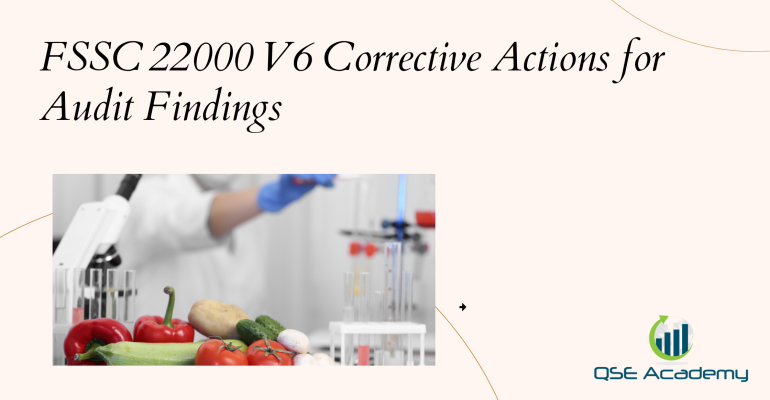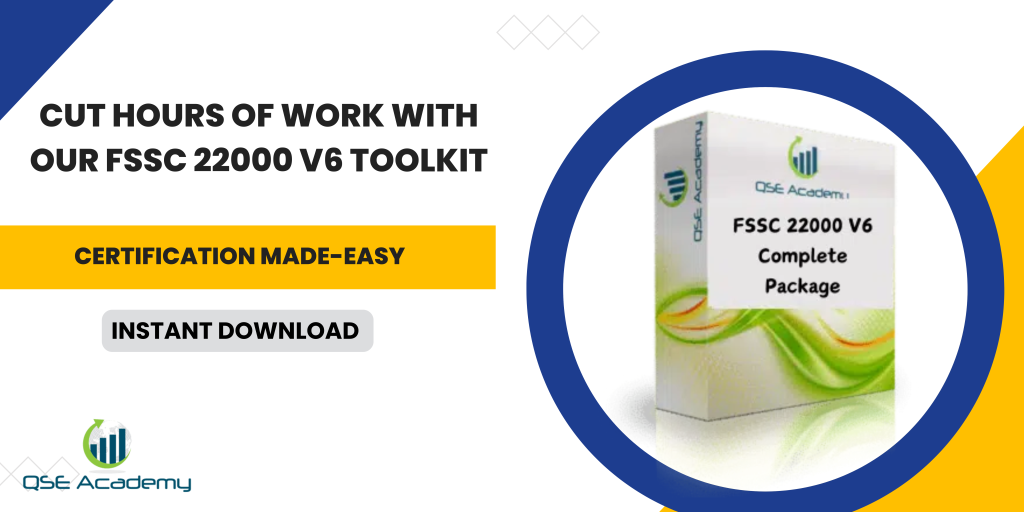FSSC 22000 V6 Corrective Actions for Audit Findings
Turn Audit Findings into Lasting Improvements
At QSE Academy, we’ve helped countless food companies fix their audit findings and avoid repeating the same mistakes.
The truth? Most organizations don’t struggle because their systems are weak — they struggle because they rush their corrective actions.
Instead of digging deep to find why an issue happened, they patch the surface, mark it “closed,” and move on. Until it shows up again in the next audit.
This guide shows you exactly how to handle FSSC 22000 V6 audit findings like a pro: identifying root causes, fixing them effectively, and proving to auditors that your Food Safety Management System (FSMS) continuously improves.
Understanding Corrective Actions in the FSSC 22000 V6 Context
Corrective actions aren’t about pointing fingers — they’re about improving systems.
Under FSSC 22000 V6 (aligned with ISO 22000:2018 Clause 10.2), your organization must prove that every nonconformity is addressed systematically and effectively.
That means you can’t just “fix” what went wrong; you need to make sure it stays fixed.
Here’s the goal:
Find the root cause.
Correct it.
Verify that it won’t happen again.
Pro Tip:
Treat every finding as free consulting from your auditor. They’ve highlighted exactly where your system can improve—use that insight.
 Step-by-Step Process for Managing Audit Findings
Step-by-Step Process for Managing Audit Findings
Let’s break down how to handle audit findings the right way — with structure, evidence, and follow-through.
a. Identify and Record the Nonconformity
Start by documenting the finding clearly and factually.
Avoid emotional language or assumptions. Stick to the facts.
Example:
Instead of writing “operator failed to monitor temperature,” record “no temperature record available for product batch #A102 on 10/05/2025.”
Categorize it as major, minor, or observation based on risk. Attach supporting evidence — photos, reports, logs, or procedures.
Common Mistake: Copying the auditor’s wording without understanding the context. Make sure your team actually knows what the issue means.
b. Contain Immediate Risk
If there’s even a hint that food safety might be compromised, take action right away.
That could mean holding product, isolating raw materials, or suspending production temporarily.
Pro Tip:
Document containment separately from corrective action. It shows you act quickly and responsibly, even before investigating the cause.
c. Analyze the Root Cause
This is where most companies go wrong. They stop too soon.
Ask “why” until you uncover the system failure — not just the surface mistake.
Use structured tools like the 5 Whys, Fishbone Diagram, or Process Mapping.
Example:
Finding: Calibration record missing.
Root Cause: No training on the document-retention process.
Corrective Action: Train staff and revise the calibration SOP to include recordkeeping steps.
Pro Tip:
Always involve cross-functional teams — QA, maintenance, and operations. Different perspectives lead to better root-cause analysis.
d. Plan and Implement Corrective Actions
Once you understand the cause, define how to fix it — permanently.
That might include:
- Updating a procedure or form
- Re-training specific staff
- Adding a control step or checklist
- Revising a work instruction
Assign responsibilities, set deadlines, and communicate the plan.
Common Mistake: Treating “training conducted” as the fix. Training is part of the action, not the action itself.
e. Verify Effectiveness
After implementation, check whether the solution actually worked.
Ask:
- Has the issue reoccurred?
- Is the new control effective?
- Is the staff applying the change consistently?
Pro Tip:
Schedule a verification review 30 to 60 days after closure. Auditors often check if you verified outcomes—so document this step clearly.
f. Close and Communicate
Once verified, record the closure in your Corrective-Action Log or CAPA Register.
Include:
- Description of finding
- Root cause
- Actions taken
- Verification evidence
- Responsible person and closure date
Finally, communicate the learning across departments. A good CAPA helps the entire organization—not just one process owner.
Root-Cause Analysis Tools that Work Best
There’s no one-size-fits-all tool, but here are the most effective:
- 5 Whys: Quick and simple for straightforward issues.
- Fishbone Diagram (Ishikawa): Helps analyze complex process failures.
- Process Mapping: Great for uncovering communication or interface gaps between teams.
Example:
A packaging plant used process mapping to find out why cleaning logs were repeatedly missed—it wasn’t laziness; it was poor handoff between shifts.
Pro Tip:
Choose the method that matches the complexity of the finding. Don’t overcomplicate simple issues.
Common Pitfalls in Corrective Actions (and How to Avoid Them)
Here’s what we see most often:
- Closing findings too fast without checking effectiveness.
- Assigning actions without ownership or follow-up.
- Using “retraining” as a cure-all.
- Ignoring deeper systemic causes (like weak management review or unclear roles).
How to Avoid These:
Use a structured CAPA template.
Assign one owner per action.
Review progress monthly.
And revisit long-term effectiveness during management review meetings.
Demonstrating Effective Corrective Actions to Auditors
When the next audit comes, auditors look for three things:
- Timely closure of previous findings.
- Evidence of real root-cause analysis.
- Proof that similar issues haven’t reappeared.
Keep a clear Corrective-Action Register showing every finding, its closure date, and verification results.
Pro Tip:
Include a summary of CAPA effectiveness in your management-review minutes—it’s a sign of maturity and proactive leadership.
Linking Corrective Actions to Continuous Improvement
Corrective actions should do more than solve problems—they should make your system stronger.
That’s how you evolve from reactive to preventive.
Encourage every department to raise internal observations, not just wait for external findings.
Example:
A bakery chain we supported used CAPA data to identify recurring training gaps. They built a focused refresher program and cut customer complaints by 50% within six months.
That’s the real power of a living FSMS.
FAQs — Closing Audit Findings the Right Way
Q1. How long do we have to close audit findings?
Usually between 28 and 90 days, depending on severity and certification body rules.
Q2. Can we close a finding with just training?
Only if the issue was purely awareness-based. Otherwise, auditors expect process-level fixes.
Q3. What if we disagree with an auditor’s finding?
You can appeal, but it’s usually more effective to investigate objectively and provide evidence that supports your position.
Conclusion — From Findings to Continuous Excellence
Every finding is an opportunity.
Handled right, corrective actions don’t just close gaps—they build stronger systems, smarter teams, and better food-safety culture.
At QSE Academy, we help clients do exactly that.
Our FSSC 22000 V6 Corrective-Action Template makes it simple to track findings, assign responsibilities, and verify closure effectively.
If you want to stop chasing the same findings and start showing real improvement, download the Corrective-Action Log Template (Excel/PDF) or book a 1-on-1 session with our team.
We’ll help you turn audit feedback into a long-term win.
Melissa Lavaro is a seasoned ISO consultant and an enthusiastic advocate for quality management standards. With a rich experience in conducting audits and providing consultancy services, Melissa specializes in helping organizations implement and adapt to ISO standards. Her passion for quality management is evident in her hands-on approach and deep understanding of the regulatory frameworks. Melissa’s expertise and energetic commitment make her a sought-after consultant, dedicated to elevating organizational compliance and performance through practical, insightful guidance.








